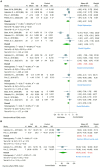Effectiveness of animal-assisted activities and therapies for autism spectrum disorder: a systematic review and meta-analysis
- PMID: 38895710
- PMCID: PMC11184216
- DOI: 10.3389/fvets.2024.1403527
Effectiveness of animal-assisted activities and therapies for autism spectrum disorder: a systematic review and meta-analysis
Abstract
Background: Given the rising interest in complementary therapeutic strategies for autism spectrum disorder (ASD), this research aims to provide a comprehensive analysis of the impact of animal-assisted activities and therapies (AAAT) on various ASD symptoms.
Methods: A meticulous search of databases, including Scopus and PubMed, was conducted to gather relevant research on AAAT for ASD. This process led to the selection of 45 studies encompassing 1,212 participants. The chosen studies were then subjected to a meta-analysis to evaluate the efficacy of AAAT in alleviating core ASD symptoms.
Results: The meta-analysis revealed significant improvements in several core ASD symptoms due to AAAT. Notably, there were improvements in social communication (MD = -4.96, 95% CI [-7.49, -2.44]), irritability (MD = -2.38, 95% CI [-4.06, -0.71]), hyperactivity (MD = -4.03, 95% CI [-6.17, -1.89]), and different word usage skills (MD = 20.48, 95% CI [7.41, 33.55]). However, social awareness (MD = -1.63, 95% CI [-4.07, 0.81]), social cognition (MD = -3.60, 95% CI [-9.36, 2.17]), social mannerisms (MD = -0.73, 95% CI [-2.55, 1.09]), social motivation (MD = -1.21, 95% CI [-2.56, 0.13]), lethargy (MD = -1.12, 95% CI [-3.92, 1.68]), and stereotypical behaviors (MD = -0.23, 95% CI [-1.27, 0.80]) did not significantly improve.
Conclusion: The study demonstrates the potential of AAAT in improving certain core symptoms of ASD, such as social communication, irritability, hyperactivity, and word usage skills. However, the effectiveness of AAAT in other ASD symptom domains remains uncertain. The research is limited by the absence of long-term follow-up data and a high risk of bias in existing studies. Therefore, while the findings indicate the promise of AAAT in specific areas, caution is advised in generalizing its efficacy across all ASD symptoms.
Keywords: animal-assisted activities and therapies; animal-assisted interventions; animal-assisted therapy; autism spectrum disorder; autistic disorder; meta-analysis.
Copyright © 2024 Xiao, Bagayi, Yang, Huang, Zhong, Kiselev, Bolkov, Tuzankina and Chereshnev.
Conflict of interest statement
The authors declare that the research was conducted in the absence of any commercial or financial relationships that could be construed as a potential conflict of interest.
Figures





Similar articles
-
Effects of Therapeutic Horseback-Riding Program on Social and Communication Skills in Children with Autism Spectrum Disorder: A Systematic Review and Meta-Analysis.Int J Environ Res Public Health. 2022 Nov 4;19(21):14449. doi: 10.3390/ijerph192114449. Int J Environ Res Public Health. 2022. PMID: 36361327 Free PMC article. Review.
-
Acetylcholinesterase inhibitors for autistic spectrum disorders.Cochrane Database Syst Rev. 2023 Jun 1;6(6):CD013851. doi: 10.1002/14651858.CD013851.pub2. Cochrane Database Syst Rev. 2023. PMID: 37267443 Free PMC article. Review.
-
Effects of Equine-Assisted Activities and Therapies for Individuals with Autism Spectrum Disorder: Systematic Review and Meta-Analysis.Int J Environ Res Public Health. 2023 Feb 1;20(3):2630. doi: 10.3390/ijerph20032630. Int J Environ Res Public Health. 2023. PMID: 36767996 Free PMC article. Review.
-
Behavioural and cognitive behavioural therapy for obsessive compulsive disorder (OCD) in individuals with autism spectrum disorder (ASD).Cochrane Database Syst Rev. 2021 Sep 3;9(9):CD013173. doi: 10.1002/14651858.CD013173.pub2. Cochrane Database Syst Rev. 2021. PMID: 34693989 Free PMC article. Review.
-
The effectiveness and adverse effects of D-cycloserine compared with placebo on social and communication skills in individuals with autism spectrum disorder.Cochrane Database Syst Rev. 2021 Feb 14;2(2):CD013457. doi: 10.1002/14651858.CD013457.pub2. Cochrane Database Syst Rev. 2021. PMID: 33583058 Free PMC article.
Cited by
-
The Experiences of Motor Skill Development in Children with Autism Spectrum Disorder (ASD) Reflected through Parental Responses.Children (Basel). 2024 Oct 14;11(10):1238. doi: 10.3390/children11101238. Children (Basel). 2024. PMID: 39457203 Free PMC article.
References
-
- American Psychiatric Association, D., & Association, A. P . Diagnostic and statistical manual of mental disorders: DSM-5, vol. 5. Washington, DC: American psychiatric association; (2013).
Publication types
Grants and funding
LinkOut - more resources
Full Text Sources

